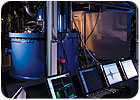
The Dynamic Spin Rig can help reduce engineering redesigns, lower the risk of in-service component failure, complete projects faster and reduce total cost. Source: Test Devices Inc.
The aerospace industry is not a forgiving one. Extensive testing is required to ensure success in the field and to avoid engine damage. Engine blade testing cannot be overlooked, and one materials testing company has developed a solution to thoroughly test engines.
Test Devices Inc. (Hudson, MA) has been developing its Dynamic Spin Rig technology for more than five years, says Dr. Boris Milatovic, director of advanced technology programs.
The first full system was built a year ago and has been a success at a customer site, a major turbine OEM. This positive feedback was no surprise to Test Devices Inc., as they worked closely with the customer, testing products for them at the Test Devices development facility. This collaboration prompted the customer to select the system, Milatovic says.
To avoid failures during engine test stand or flight testing, spin testing of new parts and components must begin early in a jet engine development program. For customers who choose to perform testing operations in-house, Test Devices offers the Dynamic Spin Rig, which closely duplicates the reality of an operating jet engine.
The Dynamic Spin Rig enables discs to be tested in real time, with the blades installed. Components are tested under centrifugal load, at operational speeds, with realistic temperature gradients, and with representative high-cycle fatigue engine orders and mode shapes. These capabilities help to reduce engineering redesigns, lower the risk of in-service component failure, complete projects faster and reduce total cost.
Though the system itself is not cheap, neither is the cost of finding design problems late in development, Milatovic says. The company maintains that component testing early and often is safer and less expensive in the long run.
The ability to test discs with the blades installed and under centrifugal load is unique to Test Devices, which offers all of these capabilities in a single system. It is the only company with a dynamic spin system on the market, Milatovic says. Though existing systems are able to provide blade testing, the method includes some risk to the engine.
“[Our] technique is the first time that you vibrate the blade. You are replicating exactly what is on the engine,” Milatovic says.
The spin rig includes a technique to detect cracks, which appear when a blade starts to develop a crack, and allows a company to monitor how the crack propagates, Milatovic says.
The spin rig can evaluate blades and define blade life, which is extremely useful during the development phase. The system can compare different blades to see how much life is left in the blades.
This is really applicable to all rotating components with different kinds of rotors, Milatovic says. It can be used for any rotating components. The system alerts operators when the blades have to be changed, as it is critical to establish the life of the blades because of the disastrous facility cost. If a blade fails, it can damage the complete engine or turbine.
“When blades fail, especially these large blades, that could cause a complete disaster,” Milatovic says.
Technology Contact
For more information contact: Test Devices Inc.571 Main St., Hudson, MA 01749-3035
[email protected]
www.testdevices.com
Specifications
The Dynamic Spin Rig capabilities include:- Precise speed control to allow for “on resonance” dwelling in order to accumulate high-cycle fatigue cycles and evaluate the life of blades under realistic operating conditions.
- Elevated temperature testing with axial and radial thermal gradients accounts for both mechanical and thermal stresses. This leads to more accurate prediction of component hot spots.
- Detection of cracks in rotating assemblies with a patented system that automatically shuts down a test when a crack has been detected, saving the flawed component for analysis.
- Measurement of the growth of components at speed to allow for correlation with elastic/plastic material models.